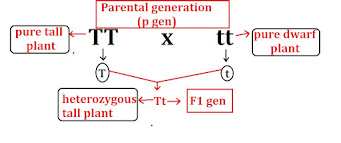Learn all about monohybrid cross:One of the reasons for Mendel's success was that he remained confined to the study of a few characters in pea plants. At first, he studied the inheritance of a single character, and then he tried adding more characters to his crosses. In this way, he thoroughly studied the inheritance pattern in pea plants.
Typical monohybrid cross: Mendel chose height character to study monohybrid cross in pea plants.
As we have discussed earlier Mendel used to cross between true-breeding(homozygous) plants (for a particular character) to get F1 generation. Thus he prepared true-breeding plants to study the character height's inheritance, one was a true-breeding tall plant with genotype TT and the other was a true-breeding dwarf plant with genotype tt.
Result of the cross:
The F1 generation plants phenotypically resembled the pure tall plant of the parental generation but genotypically F1 hybrid plants did not match with any of the parental plants because their genotypes were Tt.
Selfing: The F1 generation is self-fertilized to get the F2 generation.
Result of the cross:
Phenotypic ratio:
Tall: Dwarf
3
: 1
Genotypic ratio: TT : Tt : tt
1 : 2 : 1
Dominance relationship: The allele T is termed as dominant because in the heterozygous state Tt, it is able to express itself thus masking the effect of the t allele and the plant is hybrid tall. The allele t is called recessive because it can only express itself in the homozygous state.
This relationship between the alleles at a given locus is termed as Mendel law of dominance. In simple words, Mendel's law of dominance states that characters are controlled by units called genes. A gene has two copies for each character at a given locus called alleles, Of the two alleles, only one allele dominates the other. Although Mendel did not give this law. When scientists rediscovered Mendel's work they represented Mendel's works as laws of inheritance.
Important tricks and formulas: To solve the MCQs of genetics quickly one must learn the following tricks and formulas:
1. Types of phenotypes in F2 generation: To find the types of phenotypes the formula 2^n is used.
Where n is the no of heterozygous gene pair.
Example: In the above monohybrid cross, the types of phenotypes in the F2 generation are:
2^n
since F2 is obtained by selfing (Tt x Tt), so n is equal to 1.
so 2^1 is equal to 2.
It means there are two types of phenotypes in a monohybrid cross's F2 generation that is tall and dwarf.
2. Types of genotypes in F2 generation:
To find the types of genotypes in the F2 generation use the formula 3^n.
Where n is the no of heterozygous gene pair.
Example: In the F2 generation of monohybrid cross the types of genotypes are:
since F2 is obtained by selfing (Tt x Tt), there is one heterozygous pair so n is equal to 1.
so 3^1 equals 3.
It means the F2 generation of a monohybrid cross has 3 types of genotypes that are TT, Tt, and tt in the above example.
3. No of offspring in the F2 generation:
To find the no of offspring in the F2 generation we use the formula 4^n.
Where n is the no of heterozygous gene pair.
Example:
In the F2 generation of a monohybrid cross the no of offspring produced are:
since n is 1 for monohybrid cross so 4^1 is equal to 4.
Thus the four offspring produced are with genotype TT, Tt, Tt, and tt.







Post a Comment
0 Comments